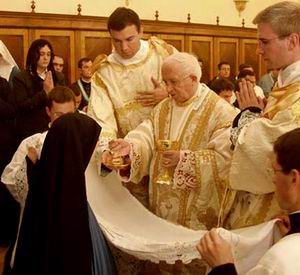From Rorate Caeli, with minute modifications for greater clarity:
St. Cyril of Jerusalem and Communion in the hand
Regarding the matter of so-called “Communion in the hand,” [Una Fides] presents an article by the Rev. Father. Giuseppe Pace, S.D.B., published in the magazine Chiesa Viva of January 1990 (Civiltà, Brescia.) [Translation by Rorate contributor Francesca Romana.]
 The acorn is a potential oak tree; the oak tree is an acorn that has come to perfection. For the oak to return to being an acorn, presuming that it could do so without dying, would be a regression. It is for this reason the Mediator Dei of Pope Pius XII condemned liturgical antiquarianism as anti-liturgical with these words: “Just as obviously unwise and mistaken is the zeal of one who in matters liturgical would go back to the rites and usage of antiquity, discarding the new patterns introduced by disposition of divine Providence to meet the changes of circumstances and situation. (no.63) (…) This way of thinking and acting [gave way] to revive the exaggerated and senseless antiquarianism to which the illegal Council of Pistoia gave rise. It likewise attempts to reinstate a series of errors which were responsible for the calling of that meeting as well as for those resulting from it, with grievous harm to souls, and which the Church, the ever watchful guardian of the “deposit of faith” committed to her charge by her divine Founder, had every right and reason to condemn. (no.64)
The acorn is a potential oak tree; the oak tree is an acorn that has come to perfection. For the oak to return to being an acorn, presuming that it could do so without dying, would be a regression. It is for this reason the Mediator Dei of Pope Pius XII condemned liturgical antiquarianism as anti-liturgical with these words: “Just as obviously unwise and mistaken is the zeal of one who in matters liturgical would go back to the rites and usage of antiquity, discarding the new patterns introduced by disposition of divine Providence to meet the changes of circumstances and situation. (no.63) (…) This way of thinking and acting [gave way] to revive the exaggerated and senseless antiquarianism to which the illegal Council of Pistoia gave rise. It likewise attempts to reinstate a series of errors which were responsible for the calling of that meeting as well as for those resulting from it, with grievous harm to souls, and which the Church, the ever watchful guardian of the “deposit of faith” committed to her charge by her divine Founder, had every right and reason to condemn. (no.64)
The pseudo – liturgists who are desolating the Church in the name of the Second Vatican Council are prey to such morbid antiquarian obsessions; pseudo-liturgists, who, at times reach the point of obligating their subjects with exhortations and instances that violate the few remaining wholesome laws that still survive, and which, they, themselves, have formally promulgated or confirmed.
Symptomatic of all this is the issue of the Rite of Holy Communion. One bishop, in fact, after declaring that the Sacred Species [being] placed on the tongue of the communicant, is still in force at the Traditional Rite, at the same time, also permits Holy Communion to be distributed in little baskets which the faithful pass along to each other; or he, himself, deposits the Sacred Species into the hands (are they always clean?) of the communicant. If you want to convince the faithful that the Most Holy Eucharist is nothing other than (a piece of) ordinary bread, perhaps even blessed as a symbolic meal, one could not imagine a better way to do it than that of sacrilege.
The promoters of Communion in the hand call upon that pseudo-liturgical antiquarianism condemned by Pius XII in apertis verbis. In fact, they say that it is in this way that you must receive It, because it had been carried out in that manner by the entire Church, both in the East and West from Her beginnings and for a thousand years afterwards.
[What] is most certainly true from the beginnings of the Church, and then for almost two thousand years, is that in preparation for Communion, communicants had to abstain from all food and drink from the night before until the moment of reception. Why don’t those antiquarians restore that Eucharistic fast? This would certainly contribute quite a bit to maintaining awareness in the mind of the communicant the thought of imminent reception of Holy Communion, so that they would dispose themselves better.
Instead, it is most certainly false that, from the Church’s beginnings and for a thousand years afterwards, the entire Church, both East and West, had the practice of placing the Sacred Species in the hands of the faithful. [our emphasis in red]
The pseudo-liturgists love to pull out the following piece from the Mystagogical Catecheses attributed to Saint Cyril of Jerusalem: «Adiens igitur, ne expansis manuum volis, neque disiunctis digitis accede; sed sinistram velut thronum subiiciens, utpote Regem suscepturæ: et concava manu suscipe corpus Christi, respondens Amen».( When thou goest to receive communion go not with thy wrists extended, nor with thy fingers separated, but placing thy left hand as a throne for thy right, which is to receive so great a King, and in the hollow of the palm receive the body of Christ, saying, Amen.)
They stop, when they arrive at this Amen; however, the Mystagogical Catecheses do not stop there, but continue:
Then, carefully sanctifying the eyes by touching them with the holy Body, partake of it,(…) “Then, after you have partaken of the Body of Christ, come forward only for the cup of the Blood. Do not stretch out your hands but bow low as if making an act of obeisance and a profound act of veneration. Say ‘Amen’. and sanctify yourself by partaking of Christ’s Blood also. While the moisture is still on your lips, touch them with your hands and sanctify your eyes, your forehead, and all your other sensory organs…Do not cut yourselves off from Communion; nor deprive yourselves of these sacred and spiritual mysteries, not even if you are defiled by sins).
Who could possibly sustain that a similar rite was more or less the custom of the universal Church for more or less a thousand years? And how to reconcile such a rite, (when even those defiled with sin are admitted to Communion), in accordance with what was certainly the universal custom from the beginnings of the Church which forbade Holy Communion to those who were not holy? «Itaque quicumque manducaverit panem hunc, vel biberit calicem Domini indigne, reus erit corporis et sanguinis Domini. Probet autem seipsum homo: et sic de pane illo edat, et de calice bibat. Qui enim manducat et bibit indigne, indicum, sibi manducat et bibit non diiudicans corpus Domini» [ [27] Therefore whosoever shall eat this bread, or drink the chalice of the Lord unworthily, shall be guilty of the body and of the blood of the Lord. [28] But let a man prove himself: and so let him eat of that bread, and drink of the chalice. [29] For he that eateth and drinketh unworthily, eateth and drinketh judgment to himself, not discerning the body of the Lord. (I Corinthians, 11, 27-29, Douay-Rheims)]
The description of such a bizarre Communion Rite, which concludes with the exhortation to receive Holy Communion even if you are defiled by sins, was most certainly not preached by St. Cyril in the Church of Jerusalem, neither would it have been licit whatsoever in any other Church. What we have here is a rite which is a product of the imagination, oscillating between fanaticism and sacrilege, by the author of the Apostolic Constitutions: an anonymous Syrian, a devourer of books, an indefatigable writer who poured into his writings, indigested and contaminated figments of own imagination. In the book VIII of the aforementioned Apostolic Constitutions, he adds 85 Canons of the Apostles, attributing them to Pope St. Clement, canons that Pope Gelasius I, at the Council of Rome in 494, declared apocryphal: «Liber qui appellatur Canones Apostolorum, apocryfus (P. L., LIX, col. 163). The description of that bizarre rite, even if not always necessarily sacrilegious, became part of the Mystagogical Catechesis through the work of a successor of St. Cyril, who most (scholars) retain was “Bishop John,” a crypto-Arian, influenced by Origen and Pelagius and thus, contested by St. Epiphanius, St. Jerome and St. Augustine.
How can Leclercq claim that «… we must see in this [in this extravagant rite] an exact representation of the usage of the great Churches of Syria»? He cannot claim this since he is contradicting himself, given that just before he states that it deals with: «…a fantasy liturgy. It does not come from nor is it destined to anything else than to entertain its author; it is not a normal, official, liturgy belonging to a specific Church» (Dictionaire de Archeologie chretienne et de Liturgie, vol. III, part II, col. 2749-2750).
Instead we have concrete evidence of customs that are the opposite, that is, of the practice of placing the Sacred Species on the tongue of the communicant, and of the prohibition of the lay faithful touching the Sacred Species with their hands. Only in cases of grave necessity and in times of persecution, St. Basil assures us, the norms could be derogated, permitting the lay to receive Communion in the hand. (P.G.,XXXII, coll. 483-486).
It is clear we do not intend to review all the testimonies invocated to demonstrate that the custom of placing the Sacred Species on the tongue of lay communicants was in use in antiquity, neither do we intend to indicate something only symptomatic, and what is more, sufficient, to disprove what they assert, that for a thousand years, the universal Church in both East and West, was in the habit of placing the Sacred Species in the hands of the faithful.
Saint Eutichiano, Pope from 275 to 283, so that laypeople would not touch the Sacred Species with their hands, forbade them to take the Blessed Sacrament to the sick: «Nullus præsumat tradere communionem laico vel femminæ ad deferendum infirmo» (Let no-one dare consign Holy Communion to a lay man or woman for them to take to the sick) (P.L.,V, coll.163-168).
Saint Gregory the Great narrates that Saint Agapito, Pope from 535 to 536, during the short months of his pontificate, went to Constantinople and healed a deaf-mute during the act of «ei dominicum Corpus in os mitteret» (placing the Body of the Lord in his mouth). (Dialogues III,3).
This was in the East but also in the West; it is known and unquestionable, that Saint Gregory the Great himself administered Holy Communion to the lay-faithful in that same manner. Even earlier, the Council of Saragozza in 380, had launched excommunication to those who dared to treat the Most Holy Eucharist as if they were in a time of persecution, a time in which even lay-people found themselves out of necessity, touching the Sacred Species with their hands. (SAENZ DE AGUIRRE, Notitia Conciliorum Hispaniæ, Salamanca, 1686, pag. 495).
Undisciplined innovators were not lacking even in antiquity. This induced the ecclesiastical authorities to call them to order. The Council of Rouen did just that, around 650, forbidding the minister of the Eucharist to place the Sacred Species in the hand of lay communicants: «[Presbyter] illud etiam attendat ut eos [fideles] propria manu communicet, nulli autem laico aut fœminæ Eucharistiam in manibus ponat, sed tantum in os eius cum his verbis ponat: “Corpus Domini et sanguis prosit tibi in remissionem peccatorum et ad vitam æternam”. Si quis hæc transgressus fuerit, quia Deum omnipotentem comtemnit, et quantum in ipso est inhonorat, ab altari removeatur» ((The Presbyter) must be mindful also of this: give Holy Communion to the faithful only by your own hand; “Do not put the Eucharist in the hands of any layman or woman but only in their mouths, with these words: ‘May the Body and Blood of the Lord help you in the remission of your sins and attain eternal life.’ Whosoever will have transgressed these norms, disdain God Almighty and in doing so will have dishonored himself and should be removed from the altar).(P.G., vol. X, coll.1099-1100).
Instead, the Arians, to show that they did not believe in the Divinity of Jesus and who retained that the Eucharist was merely symbolic bread, received Communion standing and touched the Sacred Species with their hands. It was for no small thing that Saint Athanasius could talk about the Arian apostasy. (P.G., vol. col. 9ss).
We do not deny that lay people had permission to touch the Sacred Species on occasion – in certain particular cases – or even in some particular Churches for a short period of time. But we deny that this, had been the practice in the Church in both East and West for a thousand years. It is even more false to assert that it should still be done in this way now. Besides, in the worship owed to the Most Blessed Sacrament, there has come about wise progress, similar to that which has occurred in the field of dogma (which has nothing whatsoever to do with the modernist theology of the “death of God”). The above-mentioned liturgical progress, restored universal practice of kneeling in the act of adoration, and thus the use of kneelers; the practice of covering the balustrade with a white cloth, the use of the paten, now and then a torch-bearer and the practice of at least a quarter of an hour of personal thanksgiving. Abolishing all of this does not result in increasing the worship owed to God in the Most Holy Eucharist, nor in the sanctification of the faithful, but it is serving the Devil.[Hey ! I didn’t say this, the author, a priest did.]
When St. Thomas (Summa Theologica,III,q.82,a 3) exposes the reasons that forbade laypeople to touch the Sacred Species, he does not address a rite of recent invention, but a liturgical practice as old as the Church Herself. Rightly, the Council of Trent could not only claim that it had been the consistent custom for laypeople to receive Communion from the priests, while priests communicated themselves, and that this custom, categorically, goes back to Apostolic times. (Denzinger, 881). Here is why we find it prescribed in the Catechism of St. Pius X (Questions 642-645). Now this rule has never been abrogated: in the New Roman Missal, article 117, you read that the communicant tenens patenam sub ore, sacramentum accipit (holding the paten under the mouth receives the Sacrament).
It is difficult to understand how the same promulgators of such wise norm, go about exempting the dioceses one after the other. The simple lay person faced with so much incoherence, cannot help but grow into greater indifference regarding the liturgical and non-liturgical ecclesiastical laws.




One Response to The Truth about “St. Cyril” and Communion in the Hand